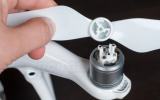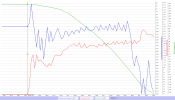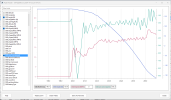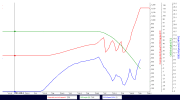Thanks but I think my luck ran out yesterday. LOLYour message is very well articulated.
Keen to follow this thread.
Good luck..
You are using an out of date browser. It may not display this or other websites correctly.
You should upgrade or use an alternative browser.
You should upgrade or use an alternative browser.
Lost Aircraft
- Thread starter RAC DJI
- Start date
As OP's query has been satisfied, the below points are more like "academic" study...Yep, that one is common too. It's sometimes quite tough to see any visible damage (like small cracks) in the prop hub area.
One thing is certain. Either the prop itself or the area of the motor where the prop attaches was damaged pre-flight or somehow became damaged after taking off.
And then I suppose one other possibility is that you didn't attach the prop properly. But, I'm thinking that one can be ruled out since the issue did not occur at/near the time of takeoff.
First Point:
I once witnessed an incident of detachment of propeller due to improper fitting. That was a Phantom 4 and during training for newbies. After ard 20 minutes of uneventful flight, the drone was controlled to landing and one of the propellers deteached (after drone landed but before the motor stopped) and flew away up to 2-3 meter high. It was recovered and found to be prefectly normal (no damage on hub or blade). The drone motor was also found to be normal (can lock the propeller well upon post incident test). So, the only possiblilties was improper installation of the propeller.
I suppose the chance of having an incident for improper attachment of propeller would be highest in the initial stage of the flight, but would also be possible anytime during flight.
Second Point:
With all the safety feature and failsafe protections in the new drone, I think that there are (at least) 4 elements which must be checked by the pilot before flight:
Airframe
-to see if the airframe are firm and any demage on the exterior of the drone
Propeller
-to see if the motors rotate smooth and if propellers are properly installed and intact
Battery
-to see if there are any swelling on the battery, sufficient power level and if it is firmly installed
Payload
-to see if any additional payload (camera in most case) are securly installed (and if the cover had been taken off, lol)
There are other things that needed to be checked but these four seems to be the most important. Any failure of the above may result in immedate crash with no warning and no chance of emergency recovery. So these are on my essentail checklist before every flight.
Any further ideas to make the flight safe are very welcome and I am all ears~
- Joined
- Oct 12, 2016
- Messages
- 30,349
- Reactions
- 34,287
- Location
- Harrisburg, PA (US)
- Site
- mavichelp.com
Much of what I share in this forum could probably be considered academic study. It comes from the first hand experience of owning nearly all consumer DJI drones ever created, personal experience helping thousands of DJI drone owner resolve issues, reading stories shared by others, and countless hours of DJI drone related research. In fact, it might be the greatest academic study anyone has ever attempted with DJI drones.As OP's query has been satisfied, the below points are more like "academic" study...
Ever owned a Phantom 2/3? Back then, there were countless stories of props being lost mid-flight as they were only screwed onto the motor and hand-tightened. DJI then created the locking system on the Phantom 4 models. And while this was a big step forward, it was by no means perfect.I once witnessed an incident of detachment of propeller due to improper fitting. That was a Phantom 4 and during training for newbies. After ard 20 minutes of uneventful flight, the drone was controlled to landing and one of the propellers deteached (after drone landed but before the motor stopped) and flew away up to 2-3 meter high. It was recovered and found to be prefectly normal (no damage on hub or blade). The drone motor was also found to be normal (can lock the propeller well upon post incident test). So, the only possiblilties was improper installation of the propeller.
The Phantom 4 prop mount is mostly made of plastic parts that wear down over time (even a short period of time if abused). The wear and tear was so common that DJI sold the replacement mounting plate parts in the DJI Store. And then fast forward to today, they don't publicly sell replacement parts like this since their more recent drones have a new locking system that is entirely made of metal. The prop itself is the only thing that is likely to wear down over time.

Now, back to the story of the one-time incident you shared. Phantom 4 props can be lost mid-flight even when using props that aren't damaged. Once the plastic starts wearing off a prop mount (or breaks away), a prop could be released at any time under just the right conditions.
Since the prop mounts on Mavics and other models of today are made of metal, the only thing you really need to worry about is the condition of the prop itself. And once that has been compromised, the props can fail much more quickly. But, that of course doesn't rule out a situation where a prop hub is slightly cracked at takeoff (for example) and the crack worsens as the flight progresses.
All good things to check! Based on the data from the flight log, I don't think any of those were a factor in this incident.With all the safety feature and failsafe protections in the new drone, I think that there are (at least) 4 elements which must be checked by the pilot before flight:
Airframe
-to see if the airframe are firm and any demage on the exterior of the drone
Propeller
-to see if the motors rotate smooth and if propellers are properly installed and intact
Battery
-to see if there are any swelling on the battery, sufficient power level and if it is firmly installed
Payload
-to see if any additional payload (camera in most case) are securly installed (and if the cover had been taken off, lol)
There are other things that needed to be checked but these four seems to be the most important. Any failure of the above may result in immedate crash with no warning and no chance of emergency recovery. So these are on my essentail checklist before every flight.
Last edited:
DJI has attributed the crash to a bird strike
That's what I thought after you posted the flight log earlier.
Thanks for the update.
.
If it was due to a birdstrike, it managed to take the prop off immediately.Hi, thanks for all your help. DJI has attributed the crash to a bird strike.
I quizzed DJI about that and they insisted the drone was not in motion and had a side collision with something.If it was due to a birdstrike, it managed to take the prop off immediately.
If it was due to a birdstrike, it managed to take the prop off immediately.
Nothing in the log indicate that one complete prop was lost instantly... on the contrary actually.I quizzed DJI about that and they insisted the drone was not in motion and had a side collision with something.
That it is a loss of thrust problem I think is pretty clear, & without the possibility to access the motor data in the DAT log I anyway bet it was a prop failure (as it's more common than motor failures).
The loss of thrust was also less than if a whole prop was lost... that it was the left rear side is clear, this as the drone drops the rear & roll over to the left, but... the drone should have started to rotate CCW (this as the left rear provides CW rotational torque).
If looking at the unwrapped yaw values (blue graph, & unwrapped means adding value if rotating CW & subtracting value if rotating CCW)... we see that the drone actually isn't rotating constantly, it begins with a CW deflection of 233 degrees (blue graph from value -181,7 to +51,3) then it turns CCW 452,5 degrees (from value +51,3 to -401,2)... then a couple more bigger back & forth movements but then continue with smaller movements, slowly adding positive value... & the blue graph slowly move up (positive direction).
This looks more like a degradation of thrust from the rear left... not a complete loss, perhaps the prop lost one blade. And that the drone initially rotate CW with 233 degrees could have been due to an outside force, by for instance a bird strike. The CCW movement that follows then, agrees with the rear left... but I believe the prop only lost one blade initially, at the 204,5sec mark we see a constant quicker decrease of the value (going to the negative more or less constantly), this is CCW repeating rotations, here I think the prop failed completely.
Furthermore, DJI will have access to much more data (through the encrypted DAT log)... access to the gyro, accelerometer & motor data would make it much easier to say exactly what happened.
Think a bird strike resulting in a damaged rear left prop followed by a later complete prop failure is plausible.

- Joined
- Oct 12, 2016
- Messages
- 30,349
- Reactions
- 34,287
- Location
- Harrisburg, PA (US)
- Site
- mavichelp.com
Without a background & without DAT data it's hard to say much more than this shows several back & forth yaw movements initially & later a consistent CW rotation... as this is paired with a height loss + speed loss... I say that this looks like a thrust loss problem, but without proper motor data we can't say anything regarding a total thrust loss or a partial.For comparison, here's a flight log where the pilot confirmed a prop detached near the end of the flight:
View attachment 178782
Update
DJI has attributed the crash to a bird strike and not failure for the aircraft. Their response email gave me two options. 1) Use care refresh flyaway coverage and pay $739 USD to replace the drone. 2) Buy a new drone and battery outright without using care refresh at $1350 USD plus tax. I had a conversation with a DJI customer service representative and with a little negotiation I was able to get the replacement fee of $159 USD. The same fee that would be charged on a care refresh claim that you were able to send in the damaged aircraft. I was very pleased with the service representative and how this was handled. Couldn’t be happier.
DJI has attributed the crash to a bird strike and not failure for the aircraft. Their response email gave me two options. 1) Use care refresh flyaway coverage and pay $739 USD to replace the drone. 2) Buy a new drone and battery outright without using care refresh at $1350 USD plus tax. I had a conversation with a DJI customer service representative and with a little negotiation I was able to get the replacement fee of $159 USD. The same fee that would be charged on a care refresh claim that you were able to send in the damaged aircraft. I was very pleased with the service representative and how this was handled. Couldn’t be happier.
Chrislaf
Well-Known Member
Glad to hear that you were able to get them to just charge you the replacement care refresh fee rather than the flyaway fee. That worked out very well.
Chris
Chris
Thanks Chris, I’ve got to say I’m very impressed with DJI service in general. I’ve never had a problem and generally very happy with all my interactions with then.
Last edited:
Chrislaf
Well-Known Member
I have had Care Refresh on every drone since my Spark and so far have never had to use it. I hope if I ever have an incident in the future that the DJI rep that I would be dealing with is as understanding as the one you had.Thanks Chris, I go to say I’m very impressed with DJI service in general. I’ve never had a problem and generally very happy with all my interactions with then.
My current drones with Refresh: Mavic 3 Pro, Mini 3 Pro, and NEO.
Chris
- Joined
- Oct 12, 2016
- Messages
- 30,349
- Reactions
- 34,287
- Location
- Harrisburg, PA (US)
- Site
- mavichelp.com
Agreed. I was just sharing because it looks very similar to the unwrapped yaw example you've provided above.Without a background & without DAT data it's hard to say much more than this shows several back & forth yaw movements initially & later a consistent CW rotation... as this is paired with a height loss + speed loss... I say that this looks like a thrust loss problem, but without proper motor data we can't say anything regarding a total thrust loss or a partial.
Is unwrapped yaw the only data you're using as an indicator to determine if the drone was spinning when a prop is potentially lost?
I'm also curious about the accuracy of unwrapped yaw in situations like this, where there are significant yaw changes. With flight log data only captured at intervals of 0.1 seconds (and sometimes 0.2 seconds), I'm not sure if there's enough data to accurately determine the correct direction for unwrapping yaw.
It ought to be more revealing than yaw values on a fixed 180 or 360 degree axis... if for instance on a 180 axis & one value is -90 & the next recorded is +10... did the drone rotate CW with 100 degrees or did it go CCW by 260 degrees?...I'm also curious about the accuracy of unwrapped yaw in situations like this, where there are significant yaw changes. With flight log data only captured at intervals of 0.1 seconds (and sometimes 0.2 seconds), I'm not sure if there's enough data to accurately determine the correct direction for unwrapping yaw.
With unwrapped it's sometimes clearer what's actually happening... if the unwrapped value goes consistently to a growing positive direction the drone mostly rotate CW (& vice versa).
- Joined
- Oct 12, 2016
- Messages
- 30,349
- Reactions
- 34,287
- Location
- Harrisburg, PA (US)
- Site
- mavichelp.com
For sure! Or at least that's the intention anyhow.It ought to be more revealing than yaw values on a fixed 180 or 360 degree axis... if for instance on a 180 axis & one value is -90 & the next recorded is +10... did the drone rotate CW with 100 degrees or did it go CCW by 260 degrees?
How can we be sure the yaw data you shared above was unwrapped in the correct direction? And if we're not sure, should we rely on that data in cases like this?
There are no wrong answers. I'm just asking your opinion since you are using that data to support your findings.
...How can we be sure the yaw data you shared above was unwrapped in the correct direction?
It's also more in this particular case that supports DJI's info about a bird strike (which have access to the DAT)... the drone rotates in the wrong direction initially if it's a thrust loss in the rear left, that CW 233 degree turn may very well be created from an outside force. After the initial CW movement the drone then goes CCW ( in a back & forth movement)... but then it slowly continue the CW rotation + that the height loss goes quicker, this I interpret as the CCW torquing motors slows down to decrease the CCW rotation & by that less vertical thrust is generated & the fall goes quicker. At 204,5sec the drone abruptly start to rotate CCW and here I guess that the drone loses the rear left prop completely...
Without more data than what's in the .txt log... we are stuck with a best guess in the end.
- Joined
- Oct 12, 2016
- Messages
- 30,349
- Reactions
- 34,287
- Location
- Harrisburg, PA (US)
- Site
- mavichelp.com
Yep! And when the line is drawn incorrectly, one might come to an entirely different conclusion.need to draw a line somewhere
With the motor data in hand, they should have easily been able to tell if it was a full prop loss or partial as you concluded. My question was more about your conclusion though. You based it solely on data that we don't know to be accurate.It's also more in this particular case that supports DJI's info about a bird strike (which have access to the DAT)
Just for fun, I created my own unwrapped yaw data:

Mine unwraps in the direction with the shortest yaw change. And I don't trust that this is accurate either since I'm not sure there is enough data in the flight log to properly unwrap it.
Last edited:
Similar threads
- Replies
- 11
- Views
- 2K
- Replies
- 9
- Views
- 2K
- Replies
- 7
- Views
- 885
- Replies
- 26
- Views
- 1K
DJI Drone Deals
New Threads
-
Mini 4 Pro Istanbul where the East meets West - Bosphorus Straits Cruise
- Started by MPone
- Replies: 0
-
-
DJI MINI 5 PRO QUICK RELEASE 360° PROPELLER GUARD Anybody Tried a set yet
- Started by Dogpilot
- Replies: 4
-
-
Members online
Total: 2,669 (members: 9, guests: 2,660)










